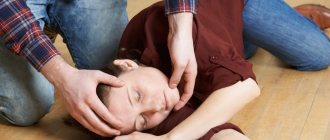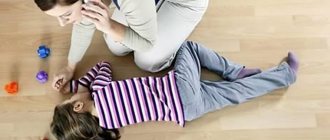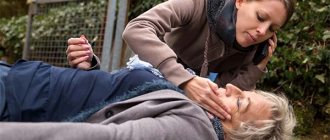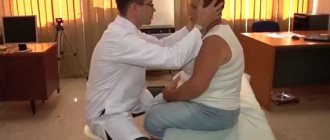Fainting (syncope) is a short-term loss of consciousness, during which muscle tone sharply decreases, then - after a minute or two - the person returns to consciousness without resuscitative measures.
There are different types of fainting, and the prognosis varies for each case. However, the essence of this condition is always that the brain does not receive enough blood, it stops working normally, and loss of consciousness occurs.
Causes of fainting
Cardiovascular diseases
Syncope associated with cardiac output obstruction
- aortic stenosis
- mitral stenosis
- hypertrophic cardiomyopathy
Syncope associated with cardiac arrhythmia
Dysregulation of vascular tone and blood volume
- reflex syncope - neurocardiogenic (vasovagal) syncope
- carotid sinus hypersensitivity
- situational syncope (coughing, sneezing, swallowing, urination, defecation, orthostatic instability syndromes)
Primary causes of autonomic failure:
- True autonomic failure
- Multiple system atrophy
- Postural otostatic tachycardia syndrome
- Acute autonomic failure
Secondary causes of autonomic dysfunction
- additional causes of orthostatic instability
Other causes of fainting
- Hypoglycemia
- hyperventilation
Subclavian steal syndrome
- decrease in circulating blood volume
- Carcinoid
- medications
Multifactorial syncope (more common in older patients)
The basis of the clinical diagnosis of syncope is a carefully collected history, which is sometimes absent due to the presence of retrograde amnesia in the patient, especially in elderly patients.
Who may have low blood pressure?
– Arterial hypotension is more common in young (under 35 years of age) women, predominantly with low body weight, who do not lead an active lifestyle, as well as in pregnant women.
Elderly and senile people (over 65 years old) with asthenia are more susceptible to postprandial hypotension (excessive decrease in blood pressure after eating. – Ed.).
In addition, low blood pressure is more often recorded in people living near busy traffic flows (railroads, highways) and in those who do not consume enough salt .
A patient with syncope should be asked the following questions:
- At what age did you first faint, and how often do you faint?
- How long did it take from the moment you realized that “something was wrong” with you until you lost consciousness? This is a key question that will allow us to assess the course of the prodromal period.
- What were you doing when the symptoms appeared? What position were you in: lying, sitting, standing, in motion?
- What sensations did you experience before losing consciousness - nausea, fullness in the stomach, increased salivation, sweating, flushing, feeling hot or cold, sudden yawning, tingling or numbness in the arms and legs, flashing “floaters” before the eyes or distorted perception, spots before the eyes ?
- Did you feel any smells, sounds, or visual distortions before you lost consciousness? Were you injured during the fall?
- Did you feel dizzy, nauseous during injections or taking blood for analysis?
- Do you get motion sickness in transport?
- Did you understand what happened to you when you woke up?
- During fainting, did you bite your tongue or cheek, did you feel weakness in half of your body after waking up, did you experience urinary or fecal incontinence during the attack?
It is also important to ask questions to the witness of the syncope, especially when seeing an elderly patient with retrograde amnesia, such as:
- What did the patient complain about before he lost consciousness?
- How long was the patient unconscious?
- Did you have any convulsions while you were unconscious?
- did the patient make involuntary sounds during loss of consciousness?
- did the patient wet himself or lose stool?
- Was the patient tense or, conversely, lethargic at the time of loss of consciousness?
- did the patient look deathly pale, with a gray or sallow complexion?
- Did you quickly realize what happened after waking up, or was you disoriented and paralyzed?
These features of the anamnesis, obtained from the patient and from the witness, make it possible to most accurately identify the cause of fainting.
Giving help
Algorithm for helping an unconscious patient:
If possible, try to support the person to avoid injury due to a fall.- Laying the person on their side will help keep the airway open.
- Elevate your legs if possible.
- Remove the victim from tight clothing.
- Sprinkle your face with water, rub your ears and cheeks.
- Bring ammonia to your nose.
- Determine the patient's pulse and blood pressure.
- If the above steps do not help, call an ambulance.
How can you prevent syncope?
- Lead a healthy lifestyle.
- Get rid of bad habits.
- Avoid stress.
- Do not move to a sitting or standing position too quickly or abruptly.
- Do physical education.
- If presyncope symptoms occur, sit or lie down with your legs elevated. Unbutton your clothes. Wash with water. Eat sweets.
- If high blood pressure is determined to be a common cause of fainting, then you need to take pills prescribed by your doctor to lower it or seek medical help. Self-prescribing medications and adjusting their dosage can be dangerous, as they can sharply lower blood pressure.
If an underlying disease is identified as the cause of syncope, treatment should be taken seriously.
Neurocardiogenic or vasovagal syncope
This type of fainting is characterized by a young age of onset of the disease, multiple repetitions of episodes of loss of consciousness over many years. The patient mentions a tendency to motion sickness and lightheadedness at the sight of blood. Most often, such fainting occurs in warmth, at rest, after physical exertion. It begins in a standing or sitting position, never lying on your back. The prodromal period usually lasts from 30 seconds to several minutes and includes symptoms such as nausea, possibly vomiting, abdominal discomfort, a feeling of heat, cold sweats, a feeling of flushing, dizziness, an increasing feeling of lightheadedness leading to loss of consciousness. Such fainting usually does not lead to bodily harm or injury. Changing to a horizontal position can interrupt the loss of consciousness. Witnesses note marked lethargy and describe how the patient “slipped” to the floor during the attack. There is no disorientation or paralysis upon awakening. There may often be a feeling of extreme fatigue that lasts for several hours.
What low blood pressure is considered life-threatening?
– Life-threatening blood pressure levels may vary for each person and situation.
When blood pressure is below 90/60 mmHg. Art. Most people experience neurological symptoms: dizziness, lightheadedness and fainting. When systolic blood pressure is below 80 mm Hg. Art. the kidneys stop performing their filtration function, shock develops.
But, for example, in hypertensive patients with initially high blood pressure, a sharp and rapid decrease in blood pressure can cause loss of consciousness and even ischemic stroke (with a systolic blood pressure of 100–110 mm Hg). But people of asthenic physique with low body weight (constitutional hypotension) with a blood pressure of 90/60 mm Hg. Art. can feel great.
Arrhythmic syncope
As a rule, these are patients over 60 years of age with a history of heart disease. Loss of consciousness occurs suddenly, with a minimal prodromal period (“I found myself lying on the floor”) and is often accompanied by physical injuries (fractures, cuts) and even an accident if the attack occurs while driving a car. The duration of the attack does not exceed 30-40 seconds.
Fainting due to congenital arrhythmic syndromes - the so-called channelopathies - is characterized by young age, a family history of sudden death in other family members, spontaneous miscarriages, sudden infant death. Loss of consciousness associated with fright, swimming (drowning), surprise. Fainting in males during physical activity, after eating a high-carbohydrate meal or poor sleep should raise suspicion of Brugada syndrome.
During epileptic seizures, from which it is very important to differentiate syncope, a typical aura occurs in the form of visual, olfactory, auditory sensations, often the same before each attack. Deja vu or jamevu. Personal injury is very common. Accompanied by fecal and urinary incontinence. Those around describe prolonged tonic-clonic convulsions, starting with stiffness, turning into lethargy, and note a turn of the head to the side during loss of consciousness. There is a bite of the tongue and cheeks. After the attack, there is confusion, disorientation, inability to remember events, and neurological deficits or paralysis of one side (Todd's palsy) often persist.
After collecting anamnesis, we perform a medical examination, during which we note the presence of injuries and physical injuries, which often indicate the presence of either cardiac pathology or the epileptic nature of the attack. Blood pressure is measured while lying on your back, sitting and standing for 30 seconds and after 2 minutes in a standing position, which helps to identify postural changes in pressure - orthostatic collapse. Pressure measurements must be taken on both sides to avoid missing aortic dissection. Heart examination - assessment of pulse, cardiac impulse, systolic ejection murmur at the base of the heart - to identify cardiogenic pathology. Also an important diagnostic technique is carotid sinus massage, which is carried out by applying pressure to the carotid artery high in the neck at the angle of the lower jaw for 5 seconds while continuously recording an ECG. After 30 seconds, similar events are carried out on the other side. A result is considered positive when provoking a pause of 3 seconds leads to the reproduction of clinical symptoms.
Along with a thorough medical examination, a 12-lead ECG is necessary. This completes the triplet, allowing a reliable diagnosis of fainting to be made. Additionally, the ECG allows you to predict the further development of events and the patient’s management tactics. Based on the data obtained, the doctor must determine whether the fainting event is an interrupted episode of sudden death or this condition is not life-threatening for the patient. This prediction is more important, even than making a diagnosis.
You can get advice from highly qualified specialists on the treatment of fainting in Samara at the specialized neurological clinic First Neurology, which is staffed by a neurologist, cardiologist, epileptologist and functional diagnostics doctor.
The diagnostic examination includes a study of biochemical blood tests, ECG, ultrasound of the heart, and, if necessary, Holter, EEG to exclude epilepsy.
We are waiting for you at one of the three clinic addresses.
What will the doctor do?
The doctor must understand what is the cause of fainting and whether there is a threat to life and health. To do this, he will ask about the episode itself, about the medical history, about the illnesses of relatives (especially about early heart problems), conduct an examination and do an electrocardiogram. It is very important to tell your doctor everything you felt before and after you fainted, as additional symptoms can be very helpful in making a diagnosis. For example, chest pain in some cases indicates acute coronary syndrome (myocardial infarction or unstable angina) or pulmonary embolism. Rapid heartbeat is often a sign of arrhythmia. Shortness of breath may be a manifestation of heart failure or pulmonary embolism. Headache in some cases indicates vascular disorders and hemorrhages.
Often, the patient, among other things, has a stool test for occult blood (this checks for bleeding in the gastrointestinal tract), a blood test to determine whether there is anemia, and a blood test for brain natriuretic peptide (this can indicate problems with heart). The woman will most likely be given a pregnancy test. The doctor can see how much your blood pressure and pulse change when you change your body position.
If the doctor believes that it is likely that carotid syncope has occurred, carotid sinus massage will be required to confirm the diagnosis.
If subarachnoid hemorrhage is suspected, a CT scan of the brain and a lumbar puncture may be needed.
If the doctor suspects that the problem is epilepsy, he will prescribe an electroencephalography.
If you suspect heart problems, your doctor may admit you for observation in the hospital, send you for an ECG and echocardiography, perform Holter monitoring (24-hour ECG recording), electrophysiological study of the heart, or coronary angiography. In difficult cases, an implantable (subcutaneous) loop ECG recorder may be installed for several months.
A high risk of severe consequences is indicated by:
- ECG abnormalities;
- structural changes in the heart;
- symptoms indicating heart failure (shortness of breath, weakness, fatigue, swelling, etc.);
- low blood pressure (systolic - “upper” - below 90 mm Hg);
- shortness of breath before or after fainting, or at the time of treatment;
- blood hematocrit is less than 30%;
- old age and the presence of concomitant diseases;
- sudden deaths in the family due to heart problems.
Our specialists
Tarasova Svetlana Vitalievna
Expert No. 1 in the treatment of headaches and migraines. Head of the Center for the Treatment of Pain and Multiple Sclerosis.
Somnologist.
Epileptologist. Botulinum therapist. The doctor is a neurologist of the highest category. Physiotherapist. Doctor of Medical Sciences.
Experience: 23 years.Derevianko Leonid Sergeevich
Head of the Center for Diagnostics and Treatment of Sleep Disorders.
The doctor is a neurologist of the highest category. Vertebrologist. Somnologist. Epileptologist. Botulinum therapist. Physiotherapist. Experience: 23 years.
Bezgina Elena Vladimirovna
The doctor is a neurologist of the highest category. Botulinum therapist. Physiotherapist. Experience: 24 years.
Dyachenko Ksenia Vasilievna
Head of the center for the treatment of dizziness and balance disorders.
The doctor is a neurologist of the highest category.
Angioneurologist. Neurorehabilitation specialist. Physiotherapist. Candidate of Medical Sciences.
Experience: 19 years.Drozdova Lyubov Vladimirovna
The doctor is a neurologist. Vertebroneurologist. Ozone therapist. Physiotherapist. Experience: 17 years.
Zhuravleva Nadezhda Vladimirovna
Head of the center for diagnosis and treatment of myasthenia gravis.
The doctor is a neurologist of the highest category. Physiotherapist. Experience: 16 years.
Palagin Maxim Anatolievich
The doctor is a neurologist. Somnologist. Epileptologist. Botulinum therapist. Physiotherapist. Experience: 6 years.
Mizonov Sergey Vladimirovich
The doctor is a neurologist. Chiropractor. Osteopath. Physiotherapist. Experience: 8 years.
Romanova Tatyana Alexandrovna
Pediatric neurologist. Experience: 24 years.
What are the signs that indicate that my blood pressure has dropped?
– There are a lot of symptoms of low blood pressure. It can be:
- dizziness, weakness, fatigue, decreased performance, drowsiness, decreased memory, slowed reaction, decreased concentration, headaches;
- feeling of heartbeat, chilliness of the extremities;
- pallor, sweating, nausea;
- pain in the neck and upper shoulder girdle, lower back, in the heart area; hearing disorders (hearing impairment, noise or crackling in the ears);
- visual disturbances (blurredness, increased variegation, loss of color perception, narrowing of visual fields, final loss of vision).
Read also
Epicondylitis
Do you know this disgusting feeling when you are passionately doing something, and suddenly, completely by accident, your elbow bumps into something hard and in that very place, after the impact of which the whole arm weakens,…
Read more
Sports injuries
Contrary to the popular belief that all athletes are completely healthy people, this particular group of patients is subject to colossal physical stress on various organs and systems, which...
More details
Chiari malformation
What is Chiari Malformation? Chiari malformation (formerly Arnold-Chiari malformation) is a congenital defect of brain development that involves the dislocation of the cerebellar tonsils into the spinal canal through the large…
More details
Gliomas
What is a glioma? Glioma is a neuroepithelial tumor, a type of tumor of the central nervous system, the source of growth of which is glial tissue. In turn, glial tissue (glia) ...
More details
Brain concussion
A concussion is a mild traumatic brain injury without damage to the bones of the vault and base of the skull. In this condition, there are no pronounced disturbances in the functioning of the brain and there are no changes...
More details
Diagnosis and treatment
Considering the fact that hypotension can serve as a symptom of many diseases or be an independent pathology, an examination is necessary to exclude diseases that could lead to a decrease in pressure. In this regard, there is no strictly defined list of examinations. To understand why the patient has low blood pressure, a diagnostic plan is drawn up and prescribed strictly individually, taking into account the patient’s history and previous diseases.
When establishing the cause of the disease, therapy usually uses complex methods aimed at restoring and strengthening the vascular wall and treating the underlying disease, if required, strengthening the autonomic nervous system and immune processes. General stimulants are prescribed, for example, drugs containing caffeine.
Many herbal preparations, so-called “folk remedies,” also have a tonic effect, which can also help with low blood pressure (hypotension). Self-administration of such drugs, however, requires great caution, because the same substances can have different effects on different people. Sometimes a paradoxical reaction and deterioration of the patient's condition may occur.
You should not self-medicate for hypotension! Only a doctor can prescribe the drugs necessary for a particular patient after he has examined the patient and established the cause of hypotension and the characteristics of its course.
How to monitor your blood pressure and control its reduction?
– In order to prevent another decrease in blood pressure, it is necessary, firstly, to determine the cause (hypothyroidism, anemia, adrenal insufficiency, taking high doses of antihypertensive drugs, etc.) and, if possible, eliminate it.
Secondly, try to avoid provoking situations and factors , observe safety conditions during verticalization, and lifestyle recommendations.
And in situations where a person anticipates developing hypotension or fainting (increased sweating, nausea), you can help yourself by using the physical counterpressure maneuvers that I described earlier.
Reproduction of CityDog.by materials is possible only with the written permission of the editors. Details here.
Is it possible to raise blood pressure on your own at home?
– At home, in order to raise blood pressure, you can drink tea or coffee, eat something salty, and quickly drink 1-2 glasses of cold water (with ice in large sips).
You can also use so-called physical counterpressure maneuvers: crossing your legs in combination with maximum tension in the muscles of the legs, abdomen and buttocks; maximum squeezing of the rubber ball in the hand; squeezing one hand with the other with gradual abduction of the hands (phalanxes of the fingers in a lock in front of the chest).
All this is done with effort, muscle tension for as long as possible, until the symptoms disappear completely.
What foods can help with low blood pressure, and which ones should not be consumed?
– For low blood pressure, as I said earlier, it is recommended to consume large amounts of table salt (up to 10 g/day) and liquids (up to 3 l/day), and caffeine-containing drinks.
With postprandial hypotension, you need to adhere to a certain type of diet: eat often, in small portions, more proteins and fats, avoid carbohydrates (especially refined ones), eat warm or cold (not hot) foods. And you should give up alcohol.









